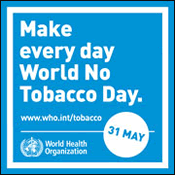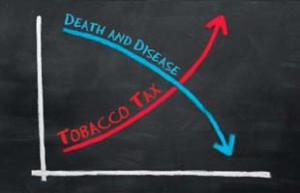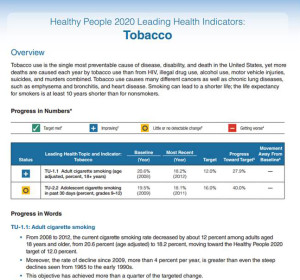 Tomorrow is World No Tobacco Day. The use of tobacco is one of the most preventable public health issues on the planet. And the global tobacco epidemic contributed to 100 million deaths around the world in the 20th century. 6 million people die every year due to tobacco use — including 600,000 deaths due to exposure to secondhand smoke.
Tomorrow is World No Tobacco Day. The use of tobacco is one of the most preventable public health issues on the planet. And the global tobacco epidemic contributed to 100 million deaths around the world in the 20th century. 6 million people die every year due to tobacco use — including 600,000 deaths due to exposure to secondhand smoke.
About 500 million people living today will be dead from the use of tobacco products if current smoking habits continue, the World Health Organization (WHO) expects.
 WHO sponsors the World No Tobacco Day every year on May 31. For this year’s policy recommendation, WHO is looking for nations to increase taxes on tobacco. The personal health economics are shown in the second graphic: increase tobacco taxes, reduce consumption and death. A simple, profound mathematical relationship.
WHO sponsors the World No Tobacco Day every year on May 31. For this year’s policy recommendation, WHO is looking for nations to increase taxes on tobacco. The personal health economics are shown in the second graphic: increase tobacco taxes, reduce consumption and death. A simple, profound mathematical relationship.
Here’s WHO’s video on this auspicious Day:
 Health Populi’s Hot Points: Where is America on this World No Tobacco Day? The most recent Healthy People 2020 Report published in March 2014 found that on the Tobacco targets, one is improving and another staying flat: adult cigarette smoking has fallen, at 18.2% in 2012 (the latest data available). But adolescent cigarette smoking in the past 30 days was at 18.1% of kids in grades 9 through 12 in 2011, which the Healthy People analysts say is virtually no statistical change from 2009’s number. The Tobacco stats are shown in the table.
Health Populi’s Hot Points: Where is America on this World No Tobacco Day? The most recent Healthy People 2020 Report published in March 2014 found that on the Tobacco targets, one is improving and another staying flat: adult cigarette smoking has fallen, at 18.2% in 2012 (the latest data available). But adolescent cigarette smoking in the past 30 days was at 18.1% of kids in grades 9 through 12 in 2011, which the Healthy People analysts say is virtually no statistical change from 2009’s number. The Tobacco stats are shown in the table.
 With this annual health holiday on my mind this morning, I saw a very visible end-cap at my local Wegmans grocery store pharmacy in suburban Philadelphia. I snapped a picture of the site, shown here, with a large sign asking, “Do you want to Quit Smoking?” On this display were arranged many forms of smoking cessation aids, including patches, lozenges and gums, and supportive “starter packs” on the top shelf. These are all well-priced — cheaper than buying a carton of smokes — and can be used with peoples’ health savings accounts.
With this annual health holiday on my mind this morning, I saw a very visible end-cap at my local Wegmans grocery store pharmacy in suburban Philadelphia. I snapped a picture of the site, shown here, with a large sign asking, “Do you want to Quit Smoking?” On this display were arranged many forms of smoking cessation aids, including patches, lozenges and gums, and supportive “starter packs” on the top shelf. These are all well-priced — cheaper than buying a carton of smokes — and can be used with peoples’ health savings accounts.
In my personal case, our family’s wellness program received through my husband’s employer has targeted smoking as the big incentive in our health plan: to participate in the “carrot” incentive for the plan (a hefty insurance premium reduction), we had to take a blood test which screened for smoking. As we are non-smokers, we will quality for this discount on our health insurance costs in 2014.
For those in our peer group who do smoke, there is this hefty incentive to quit — which could be several thousand dollars for a family of four or more in the plan. There are also smoking cessation supports of various types available to smokers.
Next year, it’s rumored we’ll be all about cholesterol lowering. We’ll have to see if red yeast rice, psyllium, fatty fish, soy and oats will be served up on the grocer’s shelf in a prominent spot a year from now.




 I am so grateful to Tom Lawry for asking me to pen the foreword for his book, Health Care Nation,
I am so grateful to Tom Lawry for asking me to pen the foreword for his book, Health Care Nation,  Thanks to Feedspot for naming this blog, Health Populi, as a
Thanks to Feedspot for naming this blog, Health Populi, as a